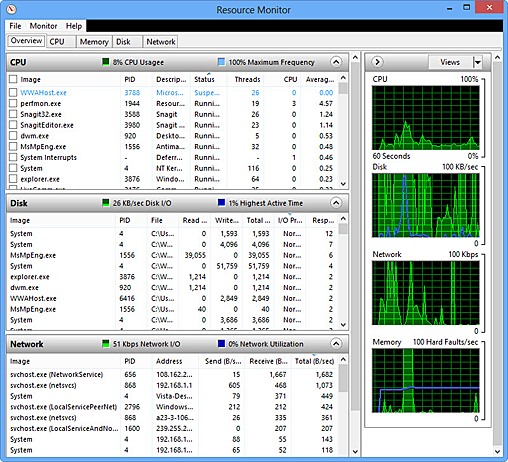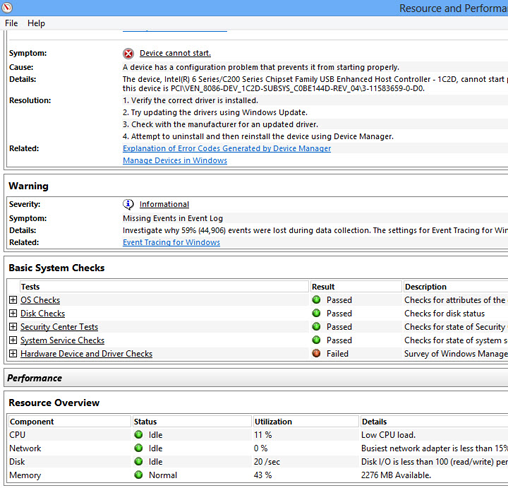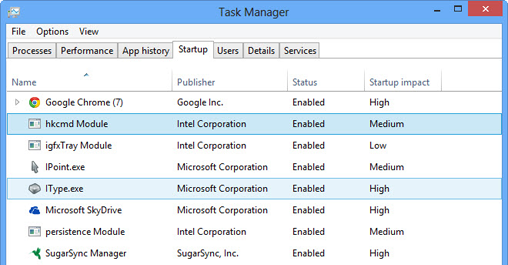How To Speed Up Computer Windows 8
How to boost Windows 8 performance
Get to know Windows 8'due south born tools for troubleshooting and speeding up your PC
There'due south an unassailable rule of calculating: No matter how fast your figurer is, and no matter how well it runs, you want it to run amend.
If you're looking to amend Windows 8, help is on the mode. I've rounded up my favorite tips for doing system assay, troubleshooting and fixing any problems you find, and in general speeding things up. No actress software is required; everything you demand is built right into Windows 8.
If you've been around the Windows block a few times, yous probably remember having to manually crank through an array of performance-oriented tasks: mucking around with page files, editing the Registry or using third-party tools such as disk cleaners. Merely over the years Windows has gotten much better at automating many of those tasks. In Windows 8, more often than not the best way to improve functioning and know what's going on in your system is to use Windows' congenital-in tools, including the Resource Monitor, the Task Manager and the Reliability Monitor.
For some reason, however, several of the nearly useful administrative tools are hidden by default, then the first thing to do is unhide them: Press the Windows key + I to open the Settings charm, click the word Tiles, and then modify the "Prove authoritative tools" slider to Aye.
With these subconscious gems revealed, we can get started.
For more useful tips, see x Windows 8 tips, tricks and hacks. If you demand help getting up to speed with Windows 8, run across Windows 8 cheat sail.
Troubleshoot sluggishness with the Resource Monitor
A little-known tool called the Resource Monitor does a very adept job of tracking down performance problems and fixing them. Although information technology's not new -- it's been included in Windows since Vista -- it'southward notwithstanding a neat way to find out about the resources your system uses and to see what applications and services are making the well-nigh use of your organisation. Based on that, you can determine which apps and services to close down and which to keep running.
To run it, blazon resmon at the Start screen and so click the resmon.exe icon that appears on the left side of the screen under Apps.
Note: If you're using a company-owned PC and don't have Administrator privileges, you may non be able to run the Resource Monitor. Simply never fear: You lot can nonetheless use the Chore Manager and virtually other tools covered in this story to troubleshoot performance problems.
If you are able to get into the Resource Monitor, showtime on the Overview tab. It offers a snapshot of your organisation'due south resource usage, including CPU use, disk utilize, network use and memory use.

The screen is divided into two. On the left-hand side you'll run into every process running on your system, past resource category (CPU, Disk, Network, and Memory), forth with details nearly the usage of each process. (A process is any programme that runs in Windows, from a tiny background task to a complex awarding such as a Web browser.)
On the right-hand side you'll see moving graphs of their cumulative apply over time. You can run into at a glance whether your CPU, disk, network or memory employ is maxing out. If any are, you know you've got a problem, and you know the general category of problem.
For more details nearly any of those categories, click the advisable tab across the tiptop of the Resource Monitor. Each tab shows you what applications or services are making use of that detail resources, along with other useful data. For instance, the CPU tab shows all the apps and services using the CPU, with a running average of CPU use for each app and service. Those that apply the CPU the virtually are listed at the elevation; those that apply it the to the lowest degree are listed at the bottom.
The display in each tab varies according to what's most useful. For case, the Retention tab shows, in addition to what programs and services are using retentivity, how much memory is currently used, cached, reserved for hardware and then on.
In one case you lot've zeroed in on the problem, you can practice something about information technology. If you've got apps and services overtaxing your CPU, for case, you lot tin shut any of them by right-clicking it and selecting Finish Process from the drib-down card. Yous might also consider looking for alternatives to those apps and services, and so using Resource Monitor later on to come across whether those alternatives have lower resource usage.
Note that most of the information that the Resource Monitor displays is also shown in the Task Manager, another built-in performance tool we'll cover after in this article. Redone for Windows 8, the Task Director has a more than comprehensive prepare of tools and information than the Resource Monitor. That said, the Resources Monitor is all the same a useful tool for troubleshooting performance problems considering information technology offers a quick at-a-glance look at your organization, with in-depth information on each of its tabs.
Track stability and troubleshoot crashes with the Reliability Monitor
Another useful Windows tool is the Reliability Monitor, first introduced in Windows Vista. It offers a historical view of overall system stability and even includes detailed data about organisation crashes. Armed with this data, you tin pinpoint the sources of problems and take steps to eliminate them.
To launch the Reliability Monitor, blazon reliability at the Start screen, click Settings, and click the "View reliability history" icon that appears on the left under Settings. The bluish line running across the graph shows your system's stability over time. It's based on a number that Windows calculates to approximate your organization's overall reliability. The maximum is 10 and the minimum is 1.
Every time at that place's a system failure, application failure or similar event, the index drops, sometimes sharply -- particularly if at that place'south been more than one failure in a day. Each day your system doesn't take a failure, the index rises a fiddling bit.
On days in that location are failures, y'all'll see ruby-red icons, divided into rows by type of failure -- application, Windows or miscellaneous (hardware, drivers, etc.). The chart too has icons for warnings about unsuccessful updates and for information about successful updates and installations.

Select any day with a failure or other event, and at the bottom of the screen you'll come across details about those events, divided into categories. Pay attending to the details of each crash and failure. Look for patterns, such as if the same application frequently crashes. If so, uninstall it, or look for an update that fixes the problem.
Finally, down at the very bottom of the screen click "View all trouble reports." Rather than seeing a chart over time, you lot'll instead come across a list of all of your problems, including summaries. It lets you curlicue through your problems more quickly than in the normal view, because they're in a long, vertical list.
Generate a detailed Performance Monitor report
Windows eight includes a Performance Monitor tool that shows an immense corporeality of detail nearly a organisation's hardware and software. Unfortunately, its main interface is well-nigh impossible to decipher. There is, notwithstanding, one manner to get some very useful information out of the Operation Monitor -- tell it to generate a detailed report for yous that pinpoints system issues and suggests fixes.
You don't create the report directly from the Functioning Monitor. Instead, from the Start screen type perfmon /study and click the "perfmn /report" icon that appears on the left. (Note that you lot might need Administrator rights to your PC to run the written report.) A screen appears telling you that a report is generated, and after a minute or two, an interactive written report appears onscreen.

The report tin be lengthy, and goes into heed-numbing detail about your system. (If y'all want to know near things such as your arrangement'south video classes and UDP data it's the place to go.) Most useful are reports of errors or problems. If information technology finds any, those will exist at the very beginning of the study. For each error or problem, information technology describes the symptom and the cause, suggests how to fix it, and provides a link to other useful information.
Streamline startup
A mutual cause of system slowdowns is programs that load unnecessarily at startup and bog downward your organisation. At that place are several ways to speed up startup.
A good place to start is the Task Manager. Yous've got several unlike means to launch the Task Manager -- take your selection:
- Press Ctrl-Shift-Esc.
- Right-click the taskbar on the Desktop and cull Task Manager.
- Blazon task manager on the Start screen, and click the Task Director icon that appears on the left under Apps.
- Press Ctrl-Alt-Del, then choose Task Manager from the screen that appears.
- Right-click the lower-left corner of your screen and select Task Manager.
If you see the phrase "More details" at the bottom of the Task Manager screen, click it. If you see the phrase "Fewer details" at the lesser of the screen, you're already in the right identify.
Now click the Startup tab. You'll meet a list of programs and services that launch when you starting time Windows. For each one, you'll see its name, its publisher, whether it'due south enabled and the "startup impact" -- how much startup is slowed down by launching it. Co-ordinate to Microsoft's developer site, apps labeled as having high startup impact use more than ane second of CPU time or more than 3MB of disk I/O at startup, medium-affect apps use 300 to thou milliseconds of CPU time or 300KB to 3MB of deejay I/O, and depression-impact apps utilize less than 300ms of CPU time and less than 300 KB of disk I/O.

If you'd like to stop whatever of the programs or services from launching at startup, correct-click it and select Disable. This doesn't disable the program entirely; it just prevents information technology from launching at startup. If you afterwards decide you want information technology to launch at startup, get back here, right-click information technology and select Enable.
Some programs might have a pocket-sized triangle next to them, indicating that they have multiple processes that run on startup. Click the triangle to see all the processes. It's non a good idea to disable some but not others, because that could crusade instability in the program. So either disable all the processes or none.
Y'all'll likely recognize some of the programs and services that run at startup, such as SkyDrive. Simply you'll also probably come across many that aren't familiar to yous and whose purpose is near impossible to discern. What to do about something called "persistence Module" or "hkcmd Module?" Should you lot plow them off or leave them on?
The Task Managing director offers some solid help. Right-click an item and select Properties, and you'll meet more item about it, including its location, whether it has a digital signature from a company you know and other information such as the version number, its size and the final time it was modified.
Alternatively, when you right-click you tin can select "Open file location" and you'll open File Explorer to the folder where the file is located. That may give you a clue well-nigh the program's purpose.
Best of all, though, is to select "Search online" subsequently y'all right-click. Bing launches and provides links to sites with data well-nigh the program or service. You'll usually very quickly detect out information about the item, including its purpose and advice on whether information technology's safe.
For more ways to use the Chore Manager to speed up your arrangement, meet "Track and fine-melody performance with the Chore Manager" later in this article.
Clean out the Startup folder
There's another place to go if you want to stop programs from launching when you showtime your system -- the Startup folder. You can run File Explorer in one of these ways:
- Press the Windows primal + E.
- Click the File Explorer icon on the Desktop's taskbar.
- Blazon file explorer on the Starting time screen and click the File Explorer icon that appears on the left.
Brand sure yous tin view hidden files in File Explorer: Click the View tab and bank check the boxes next to "Subconscious items" and "File proper noun extensions" in the Ribbon at the pinnacle.
Next, click the Calculator icon in the left pane and navigate to:
C:\Users\<em>username</em>\AppData\Roaming\Microsoft\Windows<br>\Start Menu\Programs\Startup
where username is your Windows logon. Delete the shortcuts of any programs yous don't want to run at startup. Don't worry; yous won't delete the programs themselves, only their shortcuts.
Use Fast Startup
In that location'south one last startup item to cheque: Brand sure that Windows 8 uses a new mode called Fast Startup, a hybrid of a traditional shutdown/boot operation and hibernation. When you shut down your PC, all user sessions are airtight but the Windows kernel session is saved to disk, or hibernated. And so when you beginning Windows again, it loads the hibernated arrangement session from disk, cutting startup fourth dimension.
By default, Fast Startup should be enabled on your system. But it's a skilful idea to make sure it'due south turned on, just in case your system wasn't set up correctly or Fast Startup was accidentally turned off.
On the Start screen, type power, click Settings and click the Power Options icon that appears on the left side of the screen nether Settings. Click "Choose what the ability buttons exercise" in the left pane, and nether "Shutdown settings" at the bottom of the screen that appears, brand sure that the box side by side to "Turn on fast startup" is checked.
How To Speed Up Computer Windows 8,
Source: https://www.computerworld.com/article/2484556/microsoft-windows-how-to-boost-windows-8-performance.html
Posted by: goldmanvizing.blogspot.com


0 Response to "How To Speed Up Computer Windows 8"
Post a Comment